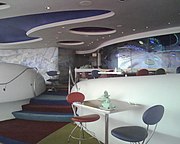


.jpg)
This design movement lasted from 1940 to 1963. It appeared during a period of great technological advancements. For example, the arms race starts in 1942 and the Cold War, in 1947. This movement really brings science and technology into the mainstream. Many different fields were influenced by the Atomic Age like architecture, industrial design, commercial design, advertising, interior design, and fine arts. Atomic Age design uses atomic motifs and space age symbols. Structures like the Atomium in Brussels are perfect examples of this. Obviously, it is inspired by the technology of the time, and the idea of futurism. As always, Atomic Age design shares many characteristics with its successor: mid-century modern.
Resources
A guide to the Atomic Age in Interior DesignPierre Cardin was a popular fashion designer during the 50s. This italian-born moved to France at the age of two. His career starts in 1946. He was the first tailor to work at Dior. In 1950, he founds his own fashion house in Paris. In 1954, Pierre presents the “Bubble Dress”, and it becomes a huge hit. The very same year, he opens his first shop “Eve”. In 1964, he releases a futuristic collection called “Cosmocorps”. Pierre was very inspired by the Space Age. He even visits NASA and tries on Neil Armstrong’s suit. Later on, he designs space suits for them.



.jpg)